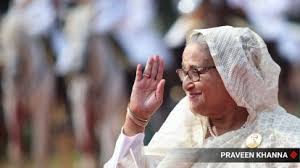Harsha Kakar
Setting aside conspiracy theories of involvement of different nations, vying to protect their vested interests, the situation in Bangladesh deteriorated due to internal flaws and mishandling by the Hasina Government. Protests against reservations, launched by students of Dacca University, the initiators to widespread violence leading to her downfall, commenced to display dissatisfaction with the High Court decision on reinstating quotas for freedom fighters.
There was logic in these demands. Sheikh Mujibur Rehman, the founder of Bangladesh, had allocated 30% quota for descendants of those who had participated in the freedom struggle. In 1972, it was a means of honouring families of those who fought for freedom, many of whom laid down their lives or were jailed and tortured. Post half a decade continuing such reservations was meaningless.
Sheikh Hasina had cancelled these quotas in Oct 2018 after students had initially protested, however these were reinstated by the High Court in Jun, based on a series of litigations filed by families of veterans of the freedom struggle. This implied that 56% of all vacancies in Government jobs would be reserved.
The students claimed that those gaining from these reservations were third generation relatives of freedom fighters, as also reinstating them would open doors for corruption and favouritism. With a downslide in the economy, jobs were already scarce. This triggered the first round of protests in Dacca university, which were largely peaceful.
The Government agreed with the students’ perspective and approached the Supreme Court against the High Court’s decision. The Supreme Court ruled that 93% of all vacancies would be on merit, with balance being reserved.This announcement was too late as by then protests had spread to multiple universities and also included anger against the Government for suppressing protests, a failing economy and lack of democratic process. The Government still did not initiate talks with student leaders.
The country’s economy was surviving on IMF backing, which had evidently dictated the nation’s budget. Losses due to violence could be high, impacting further IMF payouts. It was this which led to the Government employing excessive force to subdue protests as also Sheikh Hasina terming protestors as Razakars, a derogatory term referring to those who sided with Pakistan in 1971.
This hard approach failed,fuelling anger. Initial protests were peaceful but were subsequently infiltratedby student wings of opposition political parties in campuses, exploiting them and expanding the protests. What could have been nipped in the bud now became a movement, which was difficult to suppress. The first signs of protests gaining ground were students ousting members of Sheikh Hasina’s party members from campus hostels.
The Government’s brutal crackdown enhanced levels of violence. Another major blunder was Sheikh Hasina launching members of her students wing alongside the police to target protestors. It became a battle between law enforcement agencies and members of the Awami League against all others. The killing of nearly 100 protestors drew in thousands more.
As violence spread, members of the public joined. Social media became a catalyst spreading fake news on crackdowns and casualties. The Government, instead of negotiating and thereby ebbing the violence, shut down educational institutions. Rather than pouring water over the flames the Sheikh Hasina Government had added fuel by application of force.
The offer for dialogue came too late. By then the nation was burning. Sheikh Hasina had believed herself to be invincible. She had controlled multiple protests over the years. The BNP’s (Bangladesh Nationalist Party) protests in Oct 2023 had resulted in many dead and thousands arrested.She had over the years become an authoritarian ruler.
Human rights organizations and western nations had protested against her strong policies against the opposition, but these were ignored. There were similar protests over recently concluded elections which were backed by her allies, India, China and Russia.
This time numbers involved in violent protests were immense and they were too widespread to suppress. The police were being attacked across the country forcing them to protect themselves or abandon their posts. The only option left was to employ the army. The army chief understood the gravity and realized that employing military power could result in thousands of casualties. He backed down and chose a neutral route resulting in Sheikh Hasina’s resignation and departure.
It was students who demanded that Mohamad Yunus be appointed as head of the interim Government. They also gave a list of other members of the caretaker Government. How many were accepted from the list is unknown, however two student leaders are part of the it. Student leaders mentioned they are unwilling to accept martial law. It was students who patrolled the streets and enforced law and order as police fled.
While the students attempted to restore order, members of the opposition were targeting leaders of her Awami League. The Jamaat-e-Islami, a radical organization, subdued by Hasina, saw this as an opportunity to target minorities. Protests by students were hijacked by political parties and religious bigots to further their own agenda’s.What should have been nipped in the bud became a movement which could not be controlled.
India too has faced organized protests, many of whom had the potential of exploding had the Government employed force to subdue them. It was maturity of the Government that it let anger of the protestors recede, while containing them in their protest zones, before negotiating with them. It took time, was inconveniencing for the public, but avoided casualties, undue losses and ultimately leading to their fizzling out.
This was an option which Bangladesh could have adopted rather than attempting to violently suppress protests by students. Highhandedness does not pay and violence begets violence. Once it starts, it is difficult to subdue, especially when grievances are many and discontent within the population runs high. Historically authoritarian rulers believing in their invincibility ultimately bring about their own downfall.
The students, political parties and religious groups have understood their power. Containing them in the future will remain a challenge for any Government in Bangladesh.
The author is Major General (Retd)
Trending Now
E-Paper


